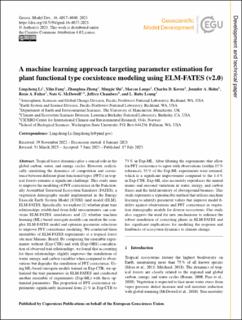| dc.contributor.author | Li, Lingcheng | |
| dc.contributor.author | Fang, Yilin | |
| dc.contributor.author | Zheng, Zhonghua | |
| dc.contributor.author | Shi, Mingjie | |
| dc.contributor.author | Longo, Marcos | |
| dc.contributor.author | Koven, Charles D. | |
| dc.contributor.author | Holm, Jennifer A. | |
| dc.contributor.author | Fisher, Rosie | |
| dc.contributor.author | McDowell, Nate G. | |
| dc.contributor.author | Chambers, Jeffrey | |
| dc.contributor.author | Leung, L. Ruby | |
| dc.date.accessioned | 2024-03-15T12:51:51Z | |
| dc.date.available | 2024-03-15T12:51:51Z | |
| dc.date.created | 2023-09-25T09:34:02Z | |
| dc.date.issued | 2023 | |
| dc.identifier.citation | Geoscientific Model Development. 2023, 16 (14), 4017-4040. | en_US |
| dc.identifier.issn | 1991-959X | |
| dc.identifier.uri | https://hdl.handle.net/11250/3122669 | |
| dc.description.abstract | Tropical forest dynamics play a crucial role in the global carbon, water, and energy cycles. However, realistically simulating the dynamics of competition and coexistence between different plant functional types (PFTs) in tropical forests remains a significant challenge. This study aims to improve the modeling of PFT coexistence in the Functionally Assembled Terrestrial Ecosystem Simulator (FATES), a vegetation demography model implemented in the Energy Exascale Earth System Model (E3SM) land model (ELM), ELM-FATES. Specifically, we explore (1) whether plant trait relationships established from field measurements can constrain ELM-FATES simulations and (2) whether machine learning (ML)-based surrogate models can emulate the complex ELM-FATES model and optimize parameter selections to improve PFT coexistence modeling. We conducted three ensembles of ELM-FATES experiments at a tropical forest site near Manaus, Brazil. By comparing the ensemble experiments without (Exp-CTR) and with (Exp-OBS) consideration of observed trait relationships, we found that accounting for these relationships slightly improves the simulations of water, energy, and carbon variables when compared to observations but degrades the simulation of PFT coexistence. Using ML-based surrogate models trained on Exp-CTR, we optimized the trait parameters in ELM-FATES and conducted another ensemble of experiments (Exp-ML) with these optimized parameters. The proportion of PFT coexistence experiments significantly increased from 21 % in Exp-CTR to 73 % in Exp-ML. After filtering the experiments that allow for PFT coexistence to agree with observations (within 15 % tolerance), 33 % of the Exp-ML experiments were retained, which is a significant improvement compared to the 1.4 % in Exp-CTR. Exp-ML also accurately reproduces the annual means and seasonal variations in water, energy, and carbon fluxes and the field inventory of aboveground biomass. This study represents a reproducible method that utilizes machine learning to identify parameter values that improve model fidelity against observations and PFT coexistence in vegetation demography models for diverse ecosystems. Our study also suggests the need for new mechanisms to enhance the robust simulation of coexisting plants in ELM-FATES and has significant implications for modeling the response and feedbacks of ecosystem dynamics to climate change. | en_US |
| dc.language.iso | eng | en_US |
| dc.publisher | Copernicus Publications | en_US |
| dc.rights | Navngivelse 4.0 Internasjonal | * |
| dc.rights.uri | http://creativecommons.org/licenses/by/4.0/deed.no | * |
| dc.title | A machine learning approach targeting parameter estimation for plant functional type coexistence modeling using ELM-FATES (v2.0) | en_US |
| dc.title.alternative | A machine learning approach targeting parameter estimation for plant functional type coexistence modeling using ELM-FATES (v2.0) | en_US |
| dc.type | Peer reviewed | en_US |
| dc.type | Journal article | en_US |
| dc.description.version | publishedVersion | en_US |
| dc.source.pagenumber | 4017-4040 | en_US |
| dc.source.volume | 16 | en_US |
| dc.source.journal | Geoscientific Model Development | en_US |
| dc.source.issue | 14 | en_US |
| dc.identifier.doi | 10.5194/gmd-16-4017-2023 | |
| dc.identifier.cristin | 2178423 | |
| dc.relation.project | EC/H2020/821003 | en_US |
| dc.relation.project | EC/H2020/101003536 | en_US |
| cristin.ispublished | true | |
| cristin.fulltext | original | |
| cristin.qualitycode | 2 | |

